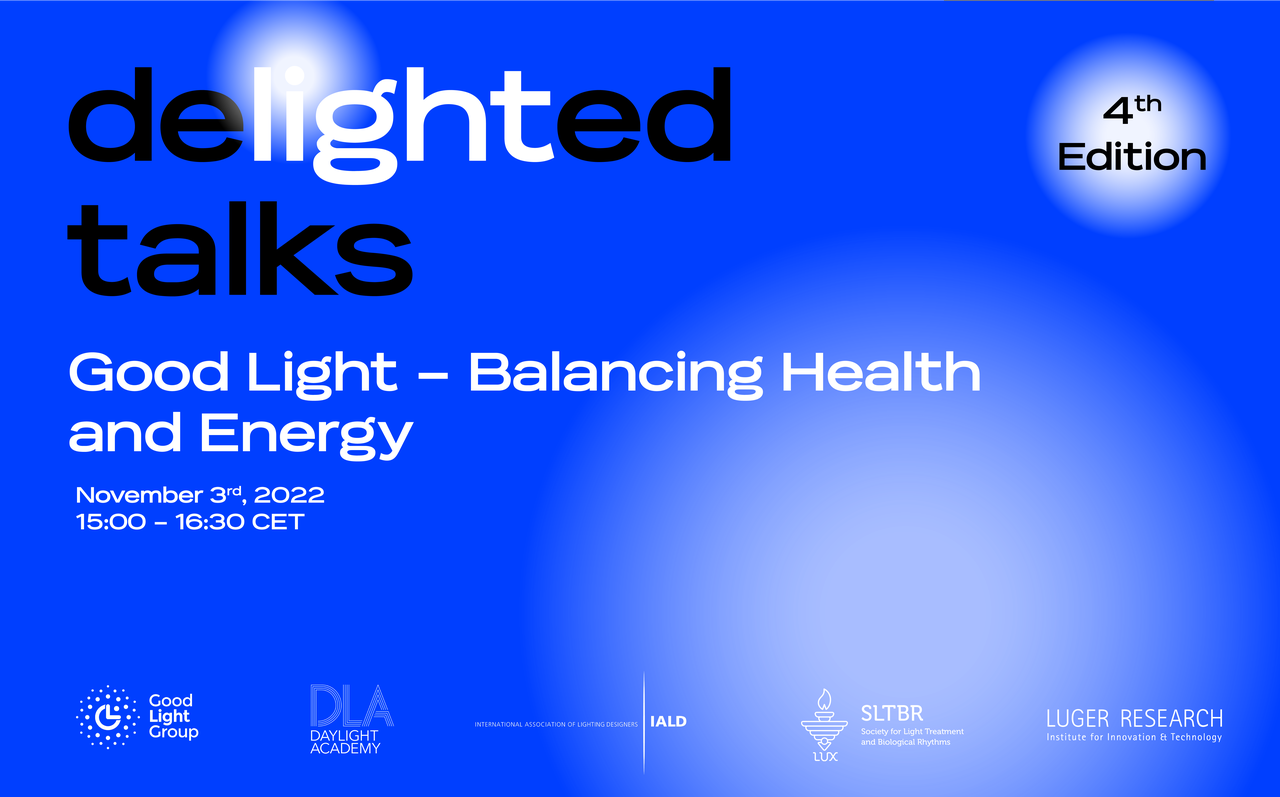deLIGHTed Talks: Good Light – Balancing Health and Energy (Nov 3, 2022)
The Good Light Group, together with the Society for Light Treatment and Biological Rhythms (SLTBR), the Daylight Academy (DLA), the International Association of Lighting Designers (IALD), and Luger Research (LR), are organizing and presenting the “Good Light – Balancing Health and Energy” lectures. The webinar explains the need for a day with Good Light and how we are able to balance health and energy issues in lighting designs.
Good Light – Balancing Health and Energy
Thursday, 3 November 2022
15:00-16:30 CET
PROGRAM
15:00 Welcome, Introduction
by Dr. Debra J. Skene, University of Surrey
15:10 "Let the Sunshine In"
by Dr. Thomas Kantermann, FOM
15:30 "Bringing Natural Daylight Indoors"
by Dr. David Geisler-Moroder and Mag. Wilfried Pohl, Bartenbach
15:50 "Balancing Health and Energy"
Panel Discussion and Q&A with the Audience
Moderation: Dr. Debra Skene, University of Surrey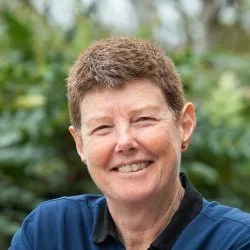 Professor Skene is Section Lead of Chronobiology at the University of Surrey. She has over 25 years of research experience studying the human circadian timing system and has authored over 190 refereed research publications. Her recent research has been funded by the EU FP6, FP7 and H2020 programmes, UK Cross Research Council New Dynamics of Ageing (NDA) Programme, BBSRC (UK), MRC Newton, NIH and Vanda Pharmaceuticals. She is a Royal Society Wolfson Research Merit Award Holder.
Professor Skene is Section Lead of Chronobiology at the University of Surrey. She has over 25 years of research experience studying the human circadian timing system and has authored over 190 refereed research publications. Her recent research has been funded by the EU FP6, FP7 and H2020 programmes, UK Cross Research Council New Dynamics of Ageing (NDA) Programme, BBSRC (UK), MRC Newton, NIH and Vanda Pharmaceuticals. She is a Royal Society Wolfson Research Merit Award Holder.
"Let the Sunshine In" by Dr. Thomas Kantermann, FOM
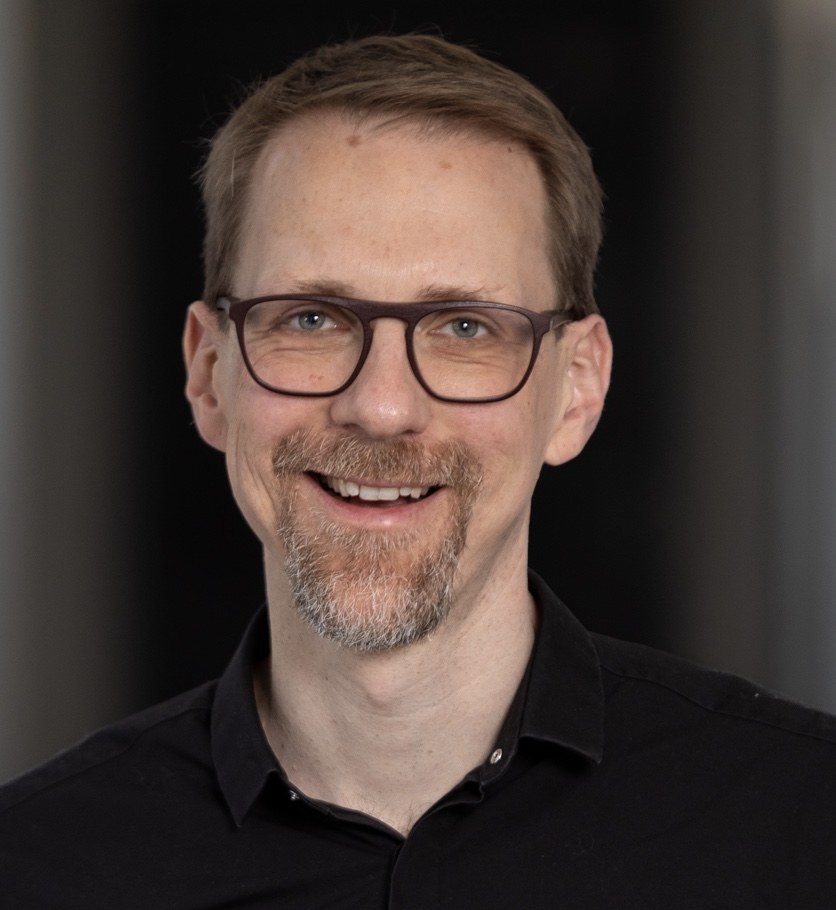 Light means life, growth, and progress. Without sunlight, life on Earth would not be possible. Sunlight, for example, ensures that plants can grow. In this way, animals, including humans, have something to eat. And humans can only find food because they have eyes that can process light. In addition, vision helps animals to not become food themselves and to find mating partners. For these reasons, among others, humans are diurnal creatures that sleep at night. The division of our biology and physiology into a diurnal activity period and a nocturnal period of relative inactivity is maintained through a circadian system. The circadian system synchronizes processes in our body to the 24-hour day. This process of biological synchronization is called entrainment. How does sunlight relate to entrainment? Entrainment relies on a predictable signal from the environment that is strong enough under diverse conditions. And sunlight does that best. Research shows that lack of sunlight and exposure to artificial light at night can disturb the process of entrainment and can compromise health and well-being. One obvious solution to this challenge is to have bright days and dark nights, a solution that is progressively more and more difficult to achieve.
Light means life, growth, and progress. Without sunlight, life on Earth would not be possible. Sunlight, for example, ensures that plants can grow. In this way, animals, including humans, have something to eat. And humans can only find food because they have eyes that can process light. In addition, vision helps animals to not become food themselves and to find mating partners. For these reasons, among others, humans are diurnal creatures that sleep at night. The division of our biology and physiology into a diurnal activity period and a nocturnal period of relative inactivity is maintained through a circadian system. The circadian system synchronizes processes in our body to the 24-hour day. This process of biological synchronization is called entrainment. How does sunlight relate to entrainment? Entrainment relies on a predictable signal from the environment that is strong enough under diverse conditions. And sunlight does that best. Research shows that lack of sunlight and exposure to artificial light at night can disturb the process of entrainment and can compromise health and well-being. One obvious solution to this challenge is to have bright days and dark nights, a solution that is progressively more and more difficult to achieve.
Dr. Thomas Kantermann studied biology and psychology (minor subject) at the University of Bielefeld (DE). He worked at the Institute for Anatomy and Neuroembryology at the University of Rostock (DE) before earning his doctorate in biology at the Ludwig-Maximilians University (LMU) in Munich (DE). He obtained his habilitation in medical psychology at the LMU. He had professional stays at the University of Surrey (UK), Charité Berlin (DE) and the Rijksuniversiteit Groningen (NL). In 2017 he started teaching at the FOM University of Applied Sciences (DE). He is a full-time university lecturer in health psychology at the FOM since 2018. He was board member of the Working Time Society, he is founding member of the Daylight Academy (Velux Foundation), and reviewer for various scientific international journals and editor at the journal Clocks & Sleep. In addition, Thomas is a freelance scientific consultant and speaker in the fields of chronobiology, sleep, and health. Headshot Image: Credits FOM University of Applied Sciences.
"Bringing Natural Daylight Indoors" by Dr. David Geisler-Moroder and Mag. Wilfried Pohl, Bartenbach
Expanding the previously energy-driven building standards and certifications to so-called “Well Building” standards will increase the importance of daylighting. And Human Centric Lighting (HCL), where the health effects (Non-Image-Forming NIF) oflightare in focus, will amplify this trend, too. Design tools with climate-based dynamic annual simulations of daylighting, artificial lighting and climate facilitate holistic planning. Hopefully, Building Information Modeling (BIM) will reduce the barriers between the trades. And last but not least, new technologies (highly reflective surfaces, nanostructured deflecting foils, etc.) will enable the development of new daylighting systems. With clever daylighting management (façade), we can save energy for lighting, cooling and heating and simultaneously increase the comfort and health of the occupants. We will show a few basics and some realized building examples.
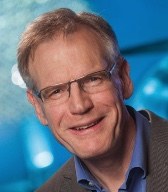
Mag. Wilfried Pohl is Director Research and member of management board at Bartenbach GmbH. Dealing with basic as well as application oriented research in artificial lighting, daylighting and building physics, visual perception and light and health. Leader of various international planning and R&D-projects in these fields. Lecturer at different universities, university teaching position at the Lighting Academy Bartenbach (a branch of the University of Innsbruck), several scientific papers and presentations, participation in international advisory boards.
Dr. David Geisler-Moroder is member of Bartenbach GmbH since 2010. David is part of the research and development team and involved in various national and international projects. He is specialized in daylighting and leads the competence field of daylight.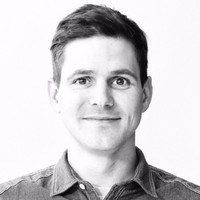

In partnership with

© 2022 Luger Research e.U. – Institute for Innovation & Technology
